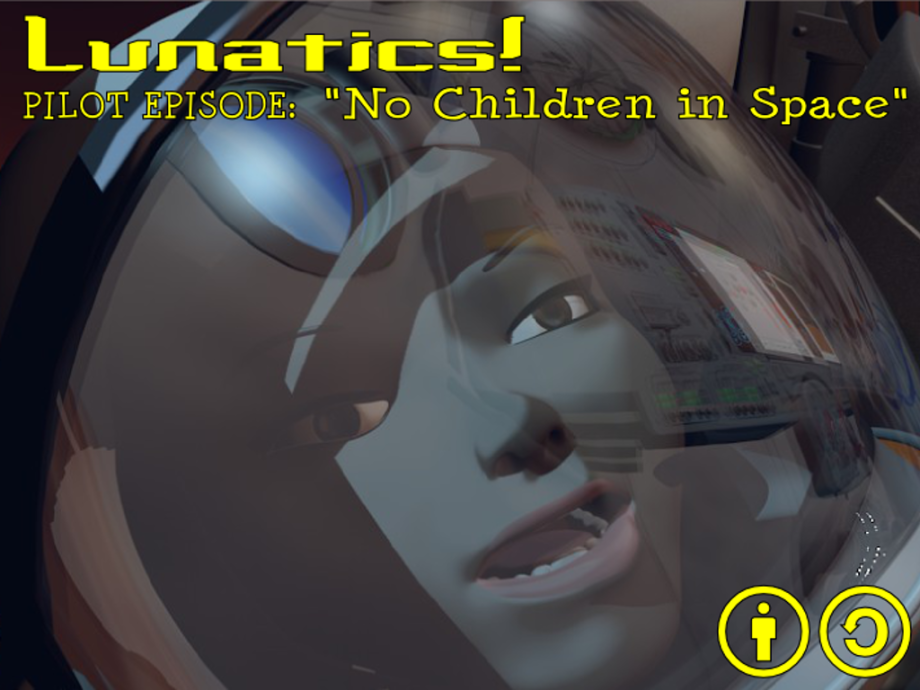I’d like to introduce you to the people who worked on Lunatics! last year, during the Summer of 2012. We worked on pre-production during the Spring of 2012, and then put out a call for Blender Internships for the Summer.
As a test project we created the assets required for the 2-minute short demonstration video on the front page:
By design, this used a minimum of 3D assets: just one set, only one character model that required facial rigging and animation, and otherwise pretty simple animation. It shows the initial flight into space, from Georgiana’s point of view.
Here’s the team that made those assets:
Cosmin Planchon
Cosmin is a French Blender artist currently working in Ireland. He’s done a lot of pretty sophisticated technical models and some NPR (non-photorealistic) rendering. He was primarily responsible for the Soyuz control console and periscope, which is a lot of what gives the look to that scene.
Of course, the console was based on Inkscape design drawings by me, which were extrapolated from the Neptune control console used on present-day Soyuz-TMA spacecraft. The main modification was to change a lot of the push buttons into a couple of touch-panels, which seemed like a reasonable design change for 2040 — a conservative simplification. They’d also be a little easier to model and animate. But in fact, it’s still a very
complicated console.
He also created “Lubo”, the Baikonur groundhog that we created after watching this silly space-agency videoin which one of the groundhogs interferes with a low-angle camera shot.
Guillaume Côté
Guillaume is a 3D modeler from Quebec. He has done some pretty sophisticated and detailed modeling.
Guillaume had possibly the hardest job. He was to make the shell of the set, representing the interior walls of the module, including the hatch mechanism on top and the parachutes. We went through quite a few revisions on that, because it’s a very complicated shape.
Andrew Pray
Andrew Pray retired from the Air Force, and took up art, including Blender modeling. He surprised me by actually doing models for some of the characters, based on the modelsheets as part of his application. That was certainly encouraging, and he was originally going to do the character design for the project.
Since he wasn’t able to continue working on the project this year, we had to drop his character models and start developing a new set (we’ve already introduced Bela Szabo, who’s been working on those).
However, one thing Andrew did especially well were the spacesuits — and those we could keep! So, both the standard “Sokol” spacesuits worn by the adults and the specially-made child spacesuit for Georgiana are his models. He also created the teddy bear that is hanging from the string in the capsule (this is a real feature of Soyuz spacecraft, by the way, we didn’t just make that up).
So the final “Georgiana in a spacesuit” model that you see in the video is a composite of both Andrew’s and Bela’s work.
Gorka Mendieta
Gorka, who we’ve already introduced, created the standard “Kazbek” acceleration couches that the adults are sitting in. This was also the base for the design of the special childsize couch Georgiana is in.
Vyacheslav Yastrebcev
Vyacheslav contributed to the Soyuz set mainly in materials and textures. He’s responsible for most of the coloring of the set. As the only native Russian-speaker of the group, he also proof-read the text on the control console and caught most, if not all, of the errors.
Later, he also created the base model for the Lunar Transportation System Lander — he made the model that appears in the animatic version of the pilot. That was later detailed and rigged by Chris Kuhn.
Vyacheslav is still working on the project — currently mostly as a translator,
although he may be involved in modeling again later on.
Sathish Kumar
Sathish is from Coimbatore, India, and he is more of a general Blender 3D artist, with some project-management experience. On this project, he created the childsize variant of the acceleration couch for Georgiana. In 2013, he created his own Blender-based 3D studio, called Spark Multimedia, and our current proposal includes partnering with his company to make the large interior sets needed for the ISF-1 colony.
Timothée Giet
Timothée is a 2D artist from France, who is skilled with Krita and Synfig. He created the animated console displays on the Soyuz control panel, based on a couple of very rough sketches by me.
Results
These artists were paid $200 each for these commissions, which were created in a fairly short time initially (although there were some tweaks after that). I had to pay that out-of-pocket at the time, which was a bit of a strain, since we hadn’t raised any money to cover it. But I think it was definitely worth it to create these assets.
And although most of the team was not available this year, I think it was a very useful earning experience for all of us. It really helped to clarify specific workflow problems and solutions for us to follow as we continue working on the project. The models did require some re-working (mainly because of scale mismatches), and it was not until this Summer that I finally got a chance to take care of all of that and animate the video as originally intended.
There are a few additional tweaks I’d like to make to the set to correct some modeling errors, but after making those further corrections, this set will probably be the one we use for the Soyuz flight in the pilot episode.
The most important thing, of course, is that it proved that we can work together on a project like this over the Internet and produce an animated film with Blender.

